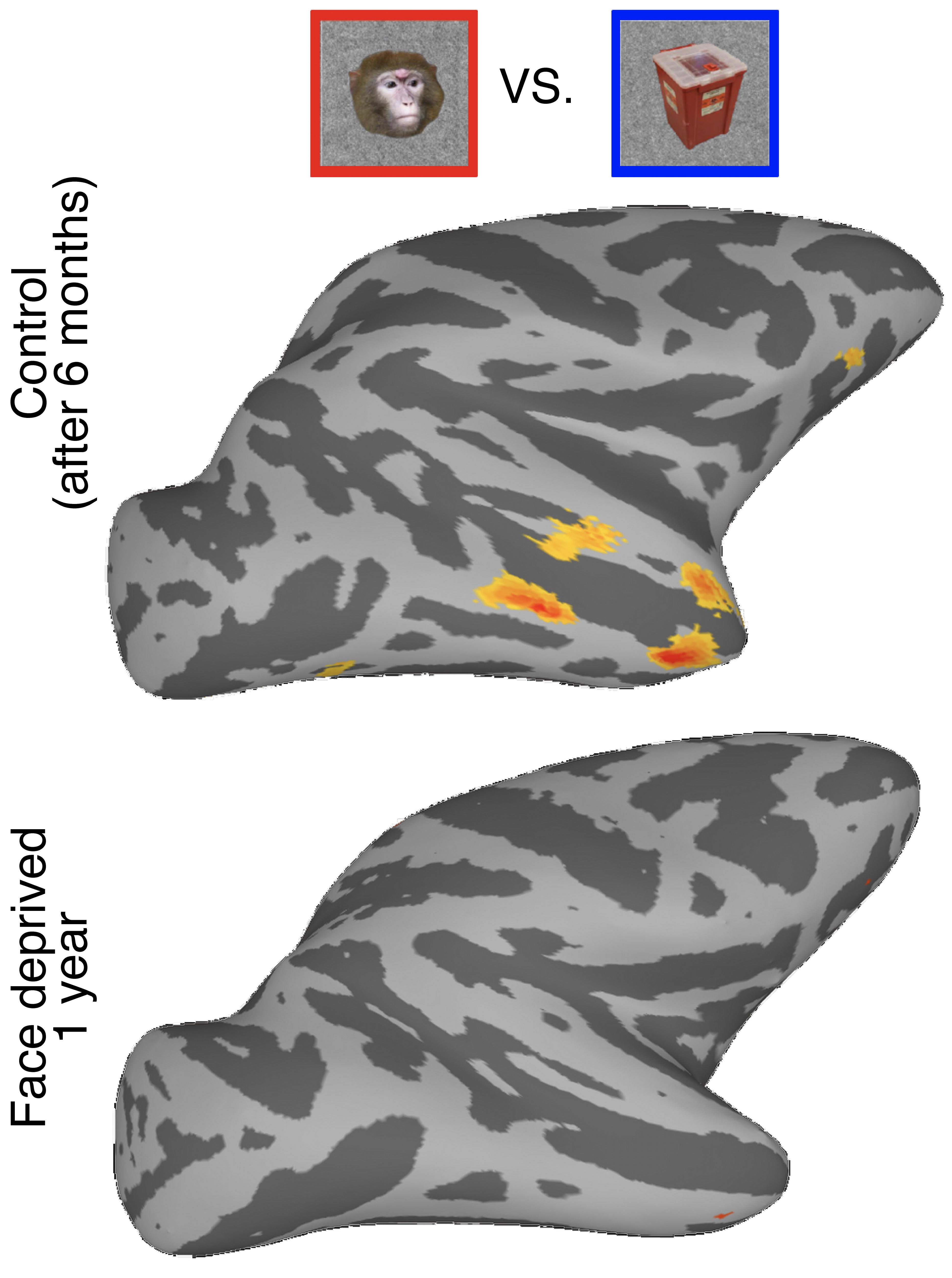Experience-driven plasticity: how does the brain change in response to visual input?
Though an impressive architecture is present in the newborn brain, critical specializations typically found in adults are not yet established. For example, we've shown that cortical domains selectively active when an individual sees a face emerge over early postnatal development and are dependent on early visual experience. Future work will be focused on understanding how the brain learns complex and invariant representations from experiencing our environment.
Selected publications:
- Scott LS & Arcaro MJ (2023). A domain-relevant framework for the development of face processing. Nature Reviews Psychology.
- Arcaro MJ, Schade PF, Livingstone MS (2019). Universal mechanisms and the development of the face network: what you see is what you get. Annual Reviews Vision Science.
- Arcaro MJ, Schade PF, Vincent JL, Ponce CR, & Livingstone MS (2017). Seeing faces is necessary for face-domain formation. Nature Neuroscience.
- Livingstone MS, Vincent JL, Arcaro MJ, Srihasam K, Schade P, Savage T (2017). Development of the macaque face-patch system. Nature Communications.

Topographic constraints on development
The anatomical location and functional properties of visual areas are similar across individuals, suggesting an early common program for their development. Our work has demonstrated that the primate brain already comprises a rich topographic representations of sensory space at birth even in brain regions thought to support behaviors that remain immature throughout early postnatal development. We've demonstrated that this organization provides a scaffolding for subsequent functional specialization of brain regions.
Selected publications:
- Arcaro MJ & Livingstone MS (2021). On the relationship between maps and domains in inferotemporal cortex. Nature Reviews Neuroscience.
- Arcaro MJ, Schade PF, Livingstone MS (2019). Body-map proto-organization in newborn macaques. PNAS.
- Arcaro MJ & Livingstone MS (2017). A hierarchical, retinotopic proto-organization of the primate visual system at birth. eLIFE.
- Livingstone MS, Vincent JL, Arcaro MJ, Srihasam K, Schade P, Savage T (2017). Development of the macaque face-patch system. Nature Communications.
Organizing principles of the brain and perception
One simple but powerful feature of brain organization is that similar functions tend to be located in close spatial proximity. In the visual cortex, this manifests as retinotopy, where adjacent neurons along the cortical surface receive input from adjacent points on the surface of the retina. Our work has demonstrated that retinotopic maps are pervasive throughout the entire visual system, support distinct visual functions, and provide a framework for establishing functional homologies across primates.
Selected publications:
- Arcaro MJ & Livingstone MS (2024). A whole-brain topographic ontology. Annual Reviews Neuroscience.
- Benson N, Jamison KW, Arcaro MJ, Vu A, Glasser MF, Coalson TS, Van Essen D, Yacoub E, Ugurbil K, Winawer J, Kay K. (2018). The HCP 7T Retinotopy: Description and pRF Analysis. Journal of Vision.
- Arcaro MJ & Livingstone MS (2017). Retinotopic organization of scene areas in the macaque inferior temporal cortex. Journal of Neuroscience.
- Arcaro MJ, Pinsk MA, Kastner S (2015). The anatomical and functional organization of the human visual pulvinar. Journal of Neuroscience.
- Arcaro MJ & Kastner S (2015). Topographic organization of areas V3 and V4 and its relation to supra-areal organization of the primate visual system. Visual Neuroscience.
- Wang L, Mruczek REB, Arcaro MJ, Kastner S (2015). Probabilistic Maps of Visual Topography in Human Cortex. Cerebral Cortex.
- Arcaro MJ, Pinsk MA, Li X, Kastner S (2011). Visuotopic organization of macaque posterior parietal cortex: An fMRI study. Journal of Neuroscience.
- Arcaro MJ*, McMains S*, Singer B, Kastner S (2009). Retinotopic organization of human ventral visual cortex. Journal of Neuroscience.
